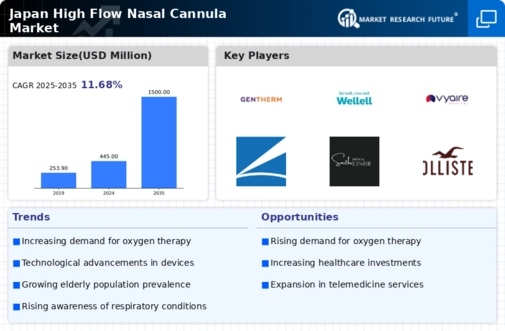Rising Prevalence of Respiratory Disorders
The increasing incidence of respiratory disorders in Japan is a primary driver for the high flow-nasal-cannula market. Conditions such as chronic obstructive pulmonary disease (COPD) and asthma are becoming more prevalent, leading to a higher demand for effective oxygen delivery systems. According to recent health statistics, approximately 5.5 million individuals in Japan are diagnosed with COPD, which necessitates advanced respiratory support. This growing patient population is likely to propel the adoption of high flow-nasal-cannula systems, as they provide enhanced oxygenation and comfort compared to traditional methods. The high flow-nasal-cannula market is thus positioned to benefit from this trend, as healthcare providers seek to improve patient outcomes through innovative respiratory therapies.
Increased Focus on Home Healthcare Solutions
The shift towards home healthcare solutions is a notable driver for the high flow-nasal-cannula market. As patients prefer receiving care in the comfort of their homes, there is a growing demand for portable and user-friendly respiratory devices. This trend is particularly relevant in Japan, where home healthcare services are expanding rapidly. The high flow-nasal-cannula market is likely to benefit from this shift, as manufacturers develop products that cater to home use, ensuring ease of operation and maintenance. The convenience of home-based care is expected to drive sales, as patients and caregivers seek effective solutions for managing respiratory conditions outside of traditional clinical settings.
Technological Innovations in Respiratory Care
Technological advancements in respiratory care are transforming the high flow-nasal-cannula market. Innovations such as improved flow rate control, integrated humidification systems, and portable devices are enhancing patient comfort and compliance. These advancements are crucial in a market where patient experience is paramount. The high flow-nasal-cannula market is witnessing a surge in demand for devices that offer both efficiency and ease of use. As healthcare providers increasingly adopt these technologies, the market is expected to expand, with a projected growth rate of around 8% annually over the next five years. This trend indicates a robust future for the industry as it adapts to evolving patient needs.
Aging Population and Increased Healthcare Demand
Japan's demographic shift towards an aging population is significantly impacting the high flow-nasal-cannula market. With over 28% of the population aged 65 and older, there is a corresponding rise in healthcare needs, particularly for respiratory support. Older adults are more susceptible to respiratory illnesses, which drives the demand for effective oxygen delivery solutions. The high flow-nasal-cannula market is likely to see increased utilization in hospitals and home care settings as healthcare systems adapt to meet the needs of this demographic. Furthermore, the government is investing in healthcare infrastructure to support this aging population, which may further enhance market growth.
Government Initiatives and Funding for Respiratory Health
Government initiatives aimed at improving respiratory health are influencing the high flow-nasal-cannula market. In Japan, public health policies are increasingly focusing on enhancing respiratory care services, which includes funding for advanced medical technologies. These initiatives are designed to improve patient outcomes and reduce healthcare costs associated with respiratory diseases. The high flow-nasal-cannula market stands to gain from these investments, as healthcare facilities are encouraged to adopt innovative solutions. With government support, the market is likely to experience growth, as more resources are allocated to respiratory health programs and technologies that improve patient care.




















Leave a Comment